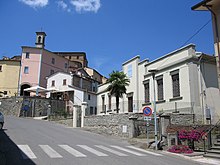Madonna del Parto

|
| Madonna del Parto |
|---|
| Piero della Francesca , 1450/75 |
| fresco |
| 260 × 203 cm |
| Museo della Madonna del Parto |
The Madonna del Parto ( Madonna of the Nativity ) is a 15th century fresco by the Italian Renaissance master Piero della Francesca .
Work history
The fresco was originally in the apse of the Santa Maria cemetery chapel in Silvis in Monterchi , a small Tuscan community. Its time of origin is given between 1450 and 1475. After the building was damaged and destroyed in an earthquake in 1785, the fresco was removed and moved to the high altar of the new Santa Maria di Momentana cemetery chapel. In 1917 this chapel was also damaged in an earthquake and the fresco was removed. It was found that under Piero's fresco there was already a depiction of the same subject from the 14th century, which had been covered by a thin layer of mortar. In 1950 the work was secured by the Florentine restorer Dino Dini (1912–1976). Since 1992 the Madonna del Parto has been housed in its own museum, which is a tourist attraction in Monterchi.
description
The image of the pregnant Madonna, widespread in Tuscany in the early 14th century, is a variation of the image of Mary . It was customary to depict the Madonna in a book, which is to be understood as an allusion to the word that has become flesh.
The Madonna del Parto by Piero della Francesca, on the other hand, does not carry a book with it, nor does it have royal attributes. The fresco shows a young woman with her left arm on her hip to support her stomach while her right hand gently touches her stomach. It is flanked by two angels painted from the same box . So they are exactly reflected in shape, posture and clothing, while they contrast in colors. The green robe of one angel corresponds to the red robe of his counterpart, while his green wings and stockings correspond to the red ones of his counterpart. With outstretched arms you hold to the side a curtain of a canopy embroidered with pomegranate motifs and lined with fur, thus opening the viewer to the pregnant Madonna. In Christian iconography , the pomegranate is a symbol of eternity and a symbol of Christ. The Madonna wears a long-sleeved blue dress that fits tight to the waist with a wide skirt and puffy upper sleeves. The dress, buttoned in the front, jumps up above the waist to over the bulging belly and reveals a white undergarment. She wears an elaborate, braided hairstyle that is tightly fitting with white ribbons. Your inward gaze is serious and painful.
The upper part of the fresco has not survived.
reception
The fresco can be seen in the 1983 film Nostalghia by Andrei Tarkowski . The Madonna del Parto plays a supporting role in Peter Henisch's novel Die schwangere Madonna from 2005, as well as in Richard Hayer's novel Visus and in the poem San Sepolcro by Jorie Graham.
literature
- Carlo Bertelli : Piero della Francesca . Life u. Work by the master of the early Renaissance. From d. It. By Anton Ebner. Cologne: DuMont 1992. XIII. Madonna del Parto. ISBN 3-7701-3058-8
Individual evidence
- ↑ Pierluigi de Vecchi (Ed.): The Complete Paintings of Piero della Francesca. Harmondsworth: Penguin Books 1970, p. 99.
- ↑ Alfredo Cattabiani: Florario . Miti, legend e simboli di fiori e piante. Milano: Mondadori 1996. pp. 331-334.
- ^ Full text , accessed April 25, 2016.
